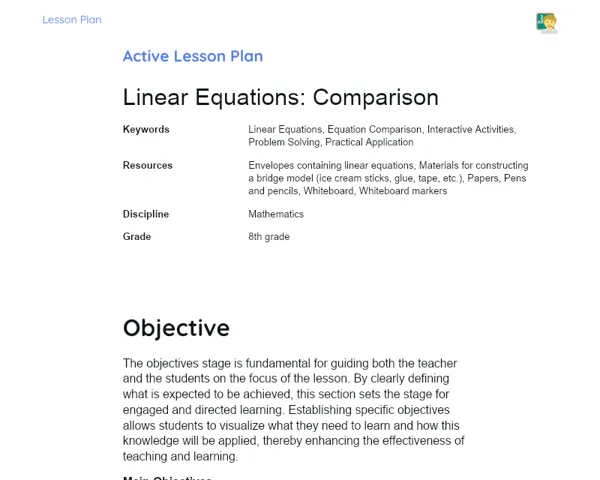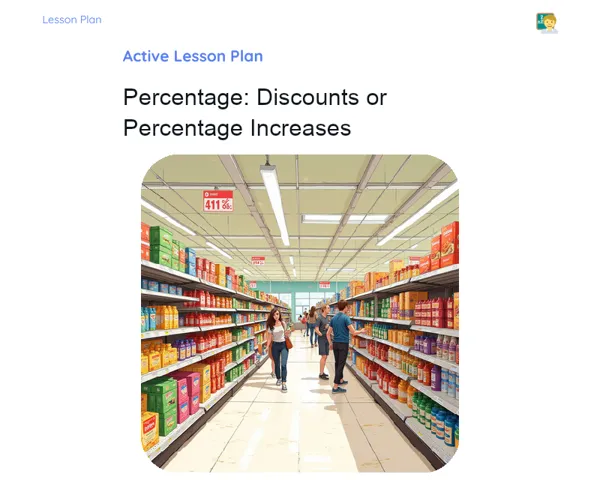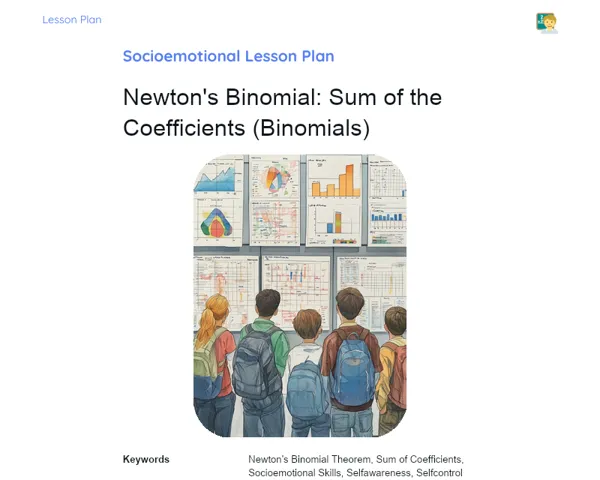Lesson Plan | Active Methodology | Area: Triangle
| Keywords | Triangle Area, Area Formula, Area Calculation, Equilateral Triangles, Isosceles Triangles, Scalene Triangles, Practical Activities, Problem Solving, Group Collaboration, Everyday Applicability, Theory and Practice, Mathematical Connection, Creative Challenges, Group Discussion |
| Necessary Materials | Graph paper, Ruler, Paints, Brushes, Scissors, Glue, Large colorful papers |
Premises: This Active Lesson Plan assumes: a 100-minute class duration, prior student study both with the Book and the beginning of Project development, and that only one activity (among the three suggested) will be chosen to be carried out during the class, as each activity is designed to take up a large part of the available time.
Objective
Duration: (5 - 10 minutes)
The Objectives stage is vital for outlining what we aim to achieve through this lesson. By clearly defining what students are expected to learn, they can direct their focus appropriately. Here, the goal is to ensure that students not only understand but can also flexibly use the formula for the area of a triangle, which will assist them in mathematical computations and enhance their analytical skills.
Objective Utama:
1. Equip students to calculate the area of triangles in various ways, using the standard formula: area = (base x height) / 2.
2. Develop the ability to identify the necessary elements for calculating the area of a triangle in different configurations, including equilateral, isosceles, and scalene triangles.
Objective Tambahan:
- Encourage teamwork among students in addressing real-world problems related to the area of triangles.
Introduction
Duration: (15 - 20 minutes)
The Introduction is designed to engage students with prior content while establishing the practical relevance of the topic. Problematic scenarios prompt students to apply theoretical understanding in real-world contexts, preparing them for the ensuing class activities. Contextualization underscores the significance and prevalence of triangle area calculations, boosting students' enthusiasm for the topic and demonstrating the practical utility of their learnings.
Problem-Based Situation
1. Imagine you’re taking part in a park design competition where you need to create a triangular garden space. How would you go about determining the area of that triangle to facilitate planning for the installation of plants?
2. Think about a situation in architecture where an architect needs to determine the number of tiles to cover the floor of a bathroom shaped like a right triangle. If only one side of the triangle is known, how could the architect find the area to ensure they purchase the correct number of tiles?
Contextualization
The area of a triangle is a fundamental measurement utilized in various professions like architecture, engineering, and even during math competitions. Understanding how to calculate the area can resolve everyday issues, for instance, determining how much fabric is required to sew a flag or optimally utilizing space in a gardening layout. Moreover, delving into the history of area calculations can enhance students' appreciation for the relevance of mathematical concepts in the real world.
Development
Duration: (70 - 80 minutes)
The Development stage empowers students to apply the knowledge gained in a practical and creative manner regarding triangle area calculations. Through group activities, they solidify their understanding of mathematical concepts, while also fostering teamwork, problem-solving, and critical thinking skills. Each activity explores the theme differently, ensuring students gain a holistic and applicable understanding of the subject.
Activity Suggestions
It is recommended that only one of the suggested activities be carried out
Activity 1 - The Secret Garden Challenge
> Duration: (60 - 70 minutes)
- Objective: Apply the concept of the area of a triangle in a hands-on garden design project.
- Description: Students will have the opportunity to design a secret garden within a triangular area on the school premises. They need to calculate the area of the base triangle (from their measurements or estimates) and meticulously plan on paper the layout of trees, flowers, and pathways, taking into account the available area.
- Instructions:
-
Divide the class into groups of up to 5 students.
-
Provide each group with graph paper and a ruler.
-
Ask each group to sketch a triangle that represents their garden space.
-
Students must calculate the area of the base triangle using the triangle area formula.
-
With the calculated area, groups should plan and illustrate their garden layout, deciding where to place each element (trees, flowers, pathways).
-
Once they finalize their designs, each group will present their garden layout and explain their choices in relation to the available area.
Activity 2 - Geometric Mystery: The Hidden Triangle
> Duration: (60 - 70 minutes)
- Objective: Enhance problem-solving abilities and practical use of the triangle area formula.
- Description: In this interactive activity, students will receive a series of clues that lead them to uncover the measures of a hidden triangle mapped out. They need to calculate the triangle's area from the discovered measures to complete the puzzle.
- Instructions:
-
Create a map featuring a 'hidden' triangle with only one of its measures disclosed.
-
Divide students into groups and hand out clues that will guide them to reveal the other measures of the triangle.
-
Each clue leads to a new measure that, when combined with the triangle area formula, helps students compute the total area.
-
The first group to accurately calculate the area and pinpoint the triangle's exact location on the map wins a small reward.
Activity 3 - Triangles in Art: Geometry and Creativity
> Duration: (60 - 70 minutes)
- Objective: Blend mathematical concepts with creative activities, promoting a deeper, practical understanding of area calculations.
- Description: Students will delve into the relationship between art and mathematics, leveraging the triangle area formula to design patterns in a painting or collage activity.
- Instructions:
-
Supply groups with large, colorful sheets of paper and materials like paints, brushes, scissors, and glue.
-
Instruct each group to draw and cut out several triangles of various sizes from the colored paper.
-
Guide students to calculate the area of each triangle.
-
Using the cut triangles and calculated areas, groups should create a visually appealing pattern or design by symmetrically gluing the triangles on a new sheet.
-
In the end, each group showcases their creations, explaining how they integrated mathematical concepts into their artistic projects.
Feedback
Duration: (10 - 15 minutes)
The aim of this stage is to encourage students to reflect on and articulate their learnings from the practical activities, solidifying their grasp of triangle area calculations and its practical applications. The group discussion fosters communication and critical thinking skills within a collaborative environment, where students can learn from each other by sharing diverse approaches and solutions.
Group Discussion
To kick off the group discussion, the teacher may ask each group to summarize their findings and any challenges faced during the activities. Following this, the teacher can pose questions that encourage students to reflect on their application of the triangle area formula in practical contexts and how group collaboration aided their learning. This discussion should be structured to enable all students to participate, share their insights, and listen to the viewpoints of their peers.
Key Questions
1. What were the primary challenges in applying the triangle area formula in your practical activities?
2. How did working together in your group enhance your understanding and effectiveness during the activities?
3. Was there any point when you had to modify the use of the area formula to address a particular problem? How did you approach that?
Conclusion
Duration: (5 - 10 minutes)
The aim of this concluding stage is to ensure students depart the lesson with a well-rounded understanding of the discussed concepts. By summarizing the content, the teacher reinforces learning while highlighting the bridge between theoretical knowledge and practical application, underscoring the significance of learning mathematics for real-life scenarios. This final review is vital for consolidating learning and empowering students to utilize their newfound knowledge in the future.
Summary
In this concluding stage, the teacher should summarize the key points discussed, reiterating the triangle area formula: area = (base x height) / 2. It is essential to revisit the various applications of this formula, such as with equilateral, isosceles, and scalene triangles, as well as how students employed it in their practical activities. This aids in solidifying knowledge and ensuring that every student comprehends the material.
Theory Connection
Throughout the lesson, the connection between theory and practical application was established via activities simulating real-world scenarios, like planning a garden based on area calculations or cracking a geometric puzzle. These exercises showcase the importance of theory in practical contexts, illustrating how mathematical concepts are invaluable across various aspects of life.
Closing
Ultimately, it's crucial to emphasize the relevance of triangle area calculations in everyday life. From architecture to interior design, mastery of area calculation aids in leveraging spaces and resources effectively, showcasing to students the direct applicability of their classroom learning to situations they will encounter in real life.



